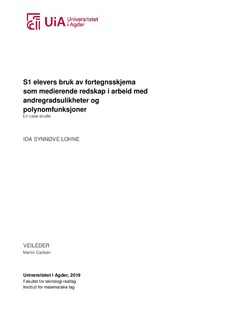| dc.description.abstract | This is a study of S1-students' use ofsign-chart as a mediating tool. The aim of the study is to determine the challenges and thebenefitsS1-students have with the use of sign-chart. To accomplish this goal, I have formulated the following research questions:What characterizes four S1-students' use of sign-chart in the resolution of second-degree inequalities and discussion of polynomial functions?I relate to a sociocultural perspective on learning and development. From this perspective, the sign-chart that students use is considered a mediating tool. According to a sociocultural perspective, tools and their meditating functions are essential for learning.As a methodical approach, I have chosen a qualitative research strategy. The research design is case study, and I have conducted an in-depth study of four S1-students and their use of sign-chart.The methods used to collect data are observation of teamwork, individual interviews and the collection of pupil responses from both group work and interview. Audio recordings have been made during the group work and interviews. The sound recordings are transcribed and carefully reviewed. To further approach an analysis of the research question, I have chosen to apply the Sfards (2007, 2008) perspective called Commognition. In this perspective, mathematics is seen as a form of discourse, a form of communication, created byword use, visual mediators, narratives and routines. Using these four terms, I will describe what characterizes students' use of sign-chart.It emerged from the analysis of the group's work that the pupils' use of sign form was characterized by misleading word use and different terminology among pupils. This challenged cooperation. The pupils benefited from sign form as visual mediator in working with second-degree inequalities. However, their routines for the discussion of polynomial functions where inflexible. From the analysis of the interviews, one student demonstrated a greater degree of individualization of the concept of the derivative, and another student a greater degree of individualization in the routine when discussing polynomial functions than what was visible from the group work. Implications for mathematics teaching from this study are as follows: In order for students to be able to use a sign-chart appropriately to discuss polynomial functions, it is essential that pupils have acquired a mathematically correct meaning behind the concept of the derivative. Explorationalroutines should be strived for. Rituals can be the predecessor for explorations. From the stage of using the abc-formula as a ritual to factorsecond-degree polynomial, students can develop more flexible routines. | nb_NO |

